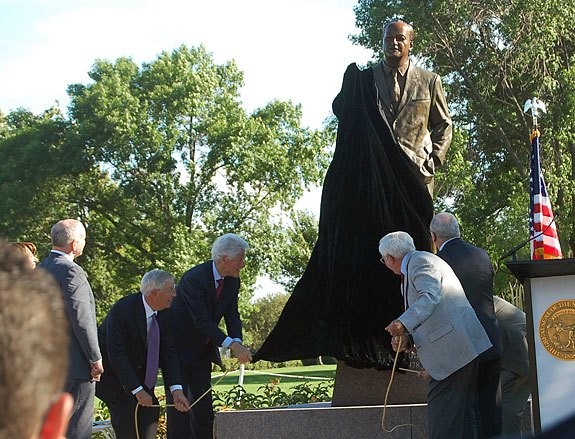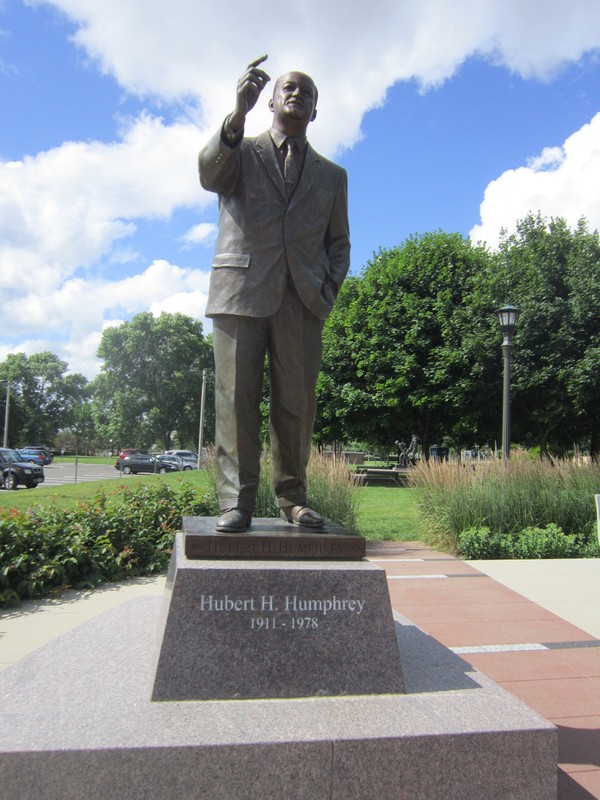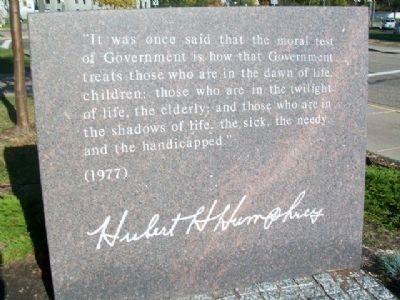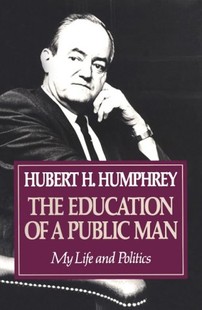Hubert Humphrey Memorial
Introduction
Text-to-speech Audio
Images
Dignitaries at the unveiling of the Hubert Humphrey Memorial Statue

Hubert Humphrey Memorial Statue Photo By William Fischer, Jr

Stone Panel Marker Photo By William Fischer, Jr

Education Of A Public Man: My Life and Politics-Click the link below to learn more about this auto-biography.

Backstory and Context
Text-to-speech Audio
In addition to serving as Lyndon B. Johnson's Vice President, Humphrey also served in the U.S. Senate and as mayor of Minneapolis. The memorial includes a quote that encapsulates the former Vice President's worldview. "It was once said that the moral test of Government is how that Government treats those who are in the dawn of life, children; those who are in the twilight of life, the elderly; and those who are in the shadows of life; the sick, the needy and the handicapped."
During his tenure as senator, Humphrey was the lead author of the Civil Rights Act of 1964. He also introduced the first initiative to create the Peace Corps, sponsored the clause of the McCarran Act to threaten concentration camps for subversives, proposed making Communist Party membership a felony and chaired the Select Committee on Disarmament.
For the last half of the 20th century, America was consumed by two struggles: the civil rights movement and the cold war. For 30 years Hubert Humphrey stood at the center of both. And while he never reached his dream of being president-and, in fact, is most remembered for his 1968 loss to Richard Nixon-Humphrey left behind a legacy few presidents can match. As a soldier of the New Deal and the Great Society he amassed one of the most prolific legislative records in Senate history sponsoring hundreds of bills-from Medicare to the Peace Corps to the Nuclear Test Ban Treaty. But Humphrey's most enduring achievements were in the areas of civil and human rights. Propelled to party prominence during the 1948 Democratic National Convention the 37-year-old mayor of Minneapolis delivered a historic speech directly challenging the racist leadership of the U.S. Senate. Almost two decades later Humphrey's extensive network of church and civil rights leaders helped him to break the longest filibuster in Senate history resulting in the passage of the Civil Rights Act of 1964. In November of 1977 for the first time in U.S. history, Congress held a special session to honor a single senator. In the words of journalist Bill Moyers "while we may not remember Hubert Humphrey's name [his] fingerprints are all over the America of today."
The statue was sculpted by the Chicago-based husband and wife team of Anna Koh-Varilla and Jeffrey Varilla. The memorial, in total, held a price tag of $678,000. $243,000 were privately raised funds.
The dedication ceremony occurred thirty years after Humphrey's death. Speakers at the dedication service included former President Bill Clinton, Gov. Mark Dayton and former Gov. Arne Carlson, former Vice President Walter Mondale, and Sens. Amy Klobuchar and Al Franken. State Sen. Dick Cohen served as master of ceremonies.
Sources
Melo, Frederick. Bill Clinton helps unveil Hubert Humphrey memorial at Minnesota Capitol. Pioneer Press. Accessed March 17, 2017. http://www.twincities.com/2012/08/03/bill-clinton-helps-unveil-hubert-humphrey-memorial-at-minnesota....
